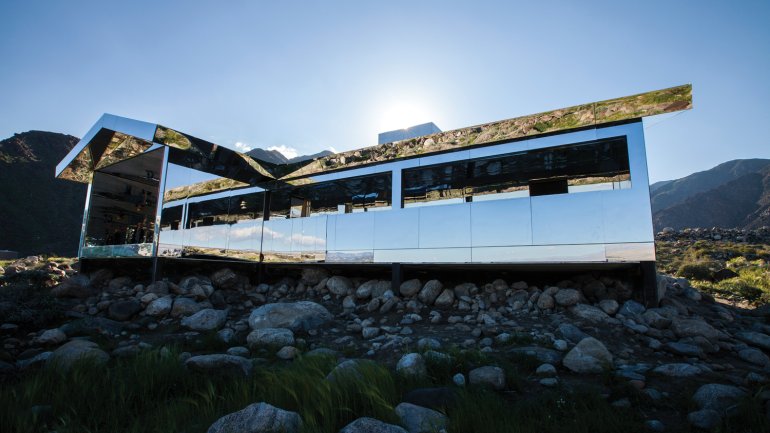Mirror, Mirror
Mirror, Mirror
Set on a rise in Palm Springs, Doug Aitken’s Mirage (2017) lives up to its name. A hyper-distilled version of the ubiquitous suburban ranch home, it has mirrors on every outward-facing surface; it sometimes reflects otherworldly sunsets and sometimes seems to disappear in blue sky. Your vantage point determines what you see, whether cloud or desert brush, air or earth. Aitken calls it a “visual echo-chamber.”
Seattle glass virtuoso Preston Singletary chafes at the conventional relationship between modern and “primitive” art. His Blue Light Spirits (2009), he says, turns the tables. Singletary’s use of Native imagery within a sleek, modern form is not an empty aesthetic or stylistic choice; it is informed by his Tlingit ancestry and the cultures of the Northwest. This is not appropriation or co-optation; instead, Singletary melds and creates something new. He raises a mirror in place of a wall, letting each artistic tradition “see” the other.
The picket fence, a classic American symbol of prosperity and contentment, is re-imagined by Brooklyn artist Alyson Shotz in Mirror Fence (2003; refabricated 2014), at Storm King Art Center in upstate New York. With a coating of reflective aluminum, what might enclose a space instead expands it: The fence runs in a 138-foot straight line, picking up whatever the particular day and season have to offer.
When he’s not teaching at New York University's Tisch School of the Arts, Daniel Rozin makes what he calls “interactive digital art” – pieces that use technology to alter themselves depending on the perspective of the observer. Mirrors Mirror (2008) is made up of 768 mirrored stainless steel tiles mounted on motors and controlled by computer and camera. As people stand in front of it, the tiles tilt up and down, constructing the viewers’ likenesses. Constantly shifting and reshaping, the piece has a ghostly effect; it makes shadows seem like solid weight.
In 2014, as part of a residency with the Artist Volunteer Center, Jamie Marie Rose Grove spent six weeks helping at homeless organizations in New York City. That experience inspired Please Do Not Feed the Birds, which she completed the following year. For the piece, Grove cast 67 glass pigeons – she notes how these birds and the homeless population are similarly ignored – and left them on a path in Tompkins Square Park, to be found and taken by anyone who happened upon them. A QR code on the bottom of each pigeon linked to a page on her website explaining the project’s history and intention.

